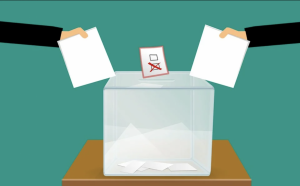Tribune Handy Guide to Voting

With the November elections coming up soon, the Wildcat Tribune puts together a comprehensive guide on voting in California
September 13, 2020
With the November elections just around the corner, the future of America lies in the hands of citizens with the responsibility of voting. However, voting can seem like a daunting, tedious process. Continue reading to learn how to vote, the various ways to vote, deadlines and more. Note that this is specific to the state of California, so only deadlines/procedures that apply to the state of California and/or to the entire United States will be mentioned.
BRIEF HISTORY OF VOTING AND ITS IMPORTANCE:
Back in 1776, voting was only available to property-owning white men aged 21 and older. The 14th Amendment granted voting rights, in addition to other benefits of citizenship, to all men born in the U.S. The 15th Amendment technically got rid of all racial barriers, but many behind-the-scenes schemes still prevented people of color from voting. Native Americans weren’t even considered. The 19th Amendment was ratified several years later, in 1920, and finally gave women the right to vote. In 1924, the Indian Citizenship Act allowed Native Americans to vote. In 1926, the federal Civil Rights Act was passed to ensure that all men and women aged 21 and older were allowed to vote regardless of race, religion, or education. In 1971, the 26th Amendment reduced the voting age to 18. Voting is not a privilege, but it’s a responsibility that we have as Americans.
DEBUNKING MYTHS ABOUT VOTING AND DEFINING SWING STATES, ELECTORAL COLLEGE:
To win the presidential election, the winning candidate must allocate 270 electoral votes. Electoral votes are given to a state based on its population. For example, California, with 55, has the most amount of electoral votes, while other states like Montana, Wyoming, Alaska, and the Dakotas each have three electoral votes, the smallest number of electoral votes given to any one state. D.C. also has 3 electoral votes, although it is not a state. Maine and Nebraska are the exceptions and divide their electoral votes into congressional districts. For most states, if you win a plurality of the popular vote, then you receive all of that state’s electoral votes. A president can win the election without winning the overall popular vote, and that has happened five times in history (1824, 1876, 1888, 2000, 2016).
Swing states are states that don’t have a history of voting for either Democratic or Republican candidates; instead, they switch, or “swing,” every election. Some examples of swing states are Ohio and Florida. Swing states are especially important because they are often the difference between a presidential candidate winning or losing, so as a result, presidential candidates generally focus all of their grassroots campaigning efforts in these states. An example of a time when a swing state provided the key factor in the election result was the 2000 election. Problems with some ballots caused a mandatory recount, but confusion over the recount ensued, which culminated in a Supreme Court decision (Bush v. Gore) that decided the winner of the election (Bush).
However, even if you do not live in a swing state, it is still important to vote. You can’t just sit back and think “oh, my state is already a Democratic state, my vote won’t matter.” This is what leads to voices not being counted or considered. It may even lead to surprising results, an example of which is Pennsylvania switching from blue (Democratic) to red (Republican) in the 2016 election.
HOW TO CHECK YOUR VOTER REGISTRATION STATUS:
If you are unsure that you are a registered voter, no worries! Checking your voter registration status also allows you to see where you are registered to vote, your political party preference, your language preference for election materials and the status of your vote-by-mail or provisional ballot. Finding your nearest polling place, information regarding local and state elections, the contact information of your county elections office and methods to receive your voting guides is also a bonus to checking your voter registration status.
You can check your registration status online here on the California Secretary of State Webpage. Enter your legal first and last name, CA driver’s license or identification card number, the last four digits of your social security number and your date of birth. Note that you should clear your browser when you are done to protect your personal information.
Once your record is found, check all your personal information to ensure it’s up-to-date with the correct addresses, contact info, voting method, and language preference for voting materials. Note that if you have recently registered online, it may take at least 24 hours for your voter registration status to be updated.
HOW TO SEND A MAIL-IN BALLOT/VARIOUS WAYS TO VOTE:
In the state of California, all registered voters are automatically sent a ballot by mail. However, if you did not receive one, you can request your absentee ballot here. There are a couple of things you need to know when voting by mail.
First, fill out your ballot carefully and make sure that you follow all of the instructions so that your vote is counted. Secondly, make sure to fill out and sign the authorization section on your ballot envelope. Your signature is your identification: make sure that this signature matches the signature that you use to sign all of your official documents.
Once you are done with this process, you are ready to mail in your ballot. Do this as soon as possible. For the ballot to be counted, it needs to be postmarked on or before Election Day, and the county has to receive it no more than 17 days after Election Day.
If you don’t want to send it by mail, you can also drop it off in a drop box or in-person at your local polling station. Anyone can turn in your ballot for you as long as they aren’t being paid to do so.
Other ways to vote include voting early in-person or voting at a polling place on Election Day (November 3, 2020, 7:00 a.m. to 8:00 p.m.)
DEADLINES:
The deadline to register to vote by mail (postmarked) or online is Oct. 19. The deadline to register in-person to vote is Nov. 3. The deadline to submit an absentee ballot application is Nov. 3 for in-person and Oct. 27 by mail. Mail-in-ballots should be postmarked by Election Day and received no later than Nov. 20. The early voting period is from Monday, October 5, 2020 to Monday, November 2, 2020, but exact dates and hours may vary. You can also register and vote on Election Day in polling centers.
HOW TO PRE-REGISTER/HOW TO REGISTER:
California is one of 14 states that allow citizens to pre-register to vote at the age of 16! You still can’t vote, but pre-registering provides sufficient time for 16-17 year-olds to get informed and engaged in the political process before they are eligible to vote.
To pre-register you should click on this link, then on “Pre-Register to Vote,” fill out the information required (you will need a form of identification!), and submit the form once you’re finished.
And then Congrats! You’re pre-registered to vote!
Registering to vote is a very similar process. Go to the same link, except click on “Register to Vote Now.” Then, fill out all of the information that is required and submit the form. You’re now registered to vote!
HOW TO GET INVOLVED:
First, try to cast out voting ballots. This can be done by reaching out to the Governor, Secretary of State, and Board of Elections. On the federal level, let the Senator know about your support of the Voting Rights Advancement Act of 2019. Don’t let COVID-19 threaten your chances of voting. Make sure to communicate on a local or federal level to protect voter access. Consider becoming a poll worker.
Spread the message! Connect with your fellow peers and take advantage of social media platforms. Ask your friends, family, activists, classmates, teachers, etc. to phone bank and text other people to ensure that they are going to vote. Additionally, nearing the end of voting days, make sure to check that everyone knows what they are doing.
Partner with advocacy groups to help educate yourself and your peers about the importance of voting. Not only will this let you become fully educated about voting, but it’s another great way to spread the message!
HOW TO ENCOURAGE OTHERS TO VOTE:
The main goal is to educate young voters on their civic responsibility to vote; this country is one that they’re inheriting, so it’s up to them to vote for and influence legislation that reflects the country that they want to live in.
Engage people who “don’t do politics”; it’s important to remember that politics affects us all. It reflects the quality of the schools you attend, the healthcare you receive, and even the water that you drink. It’s alright to not dedicate 100% of your time to political efforts, but it’s important to stay informed and vote because politics and voting shape the world everyone lives in.












